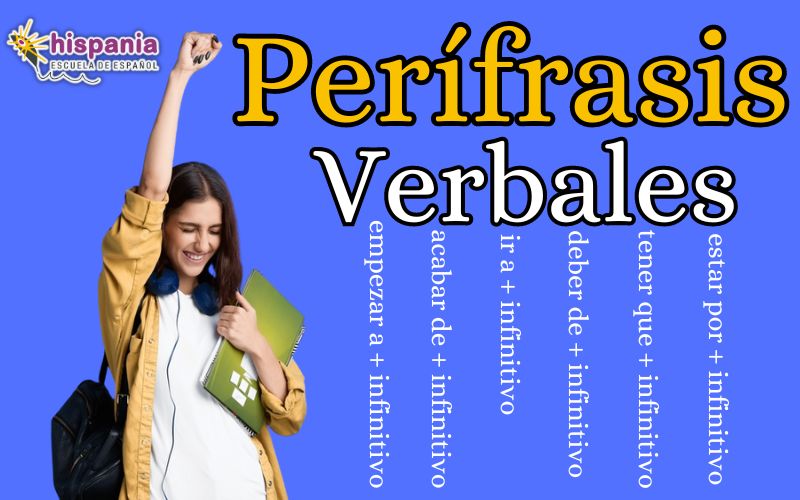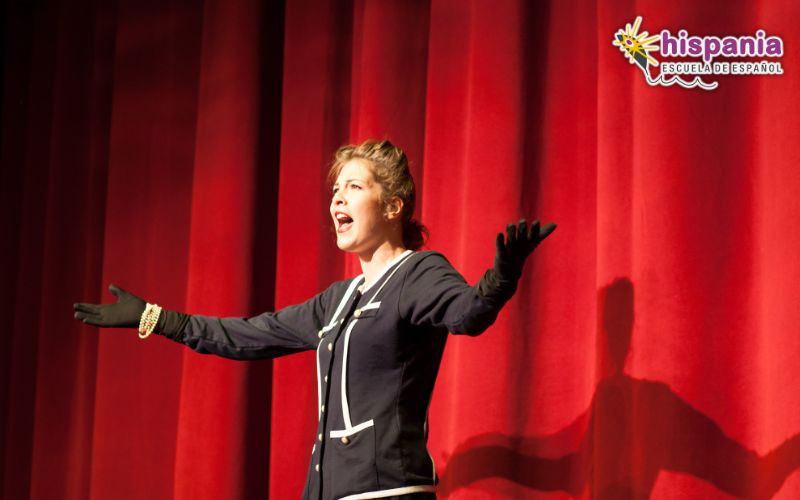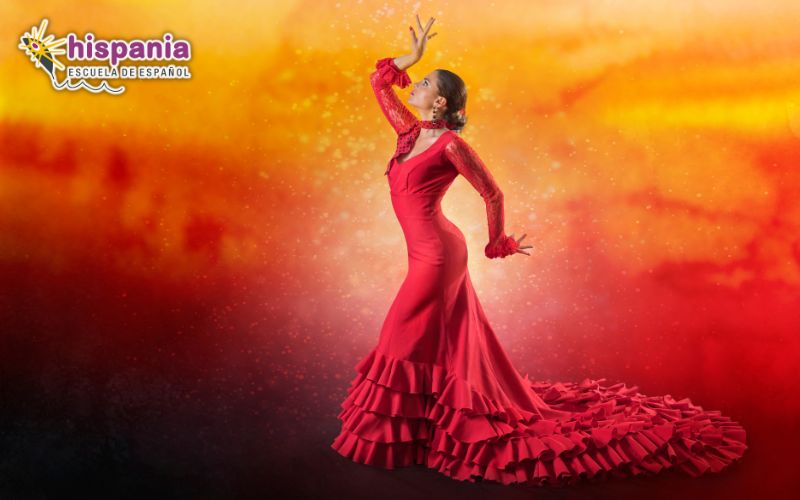
The 30 most popular traditional Spanish dances and dances
You like dancing? If you are interested in or curious about the world of dance, this article is especially for you.
We are going to take a look at the verbs dances of Spain tradicionales More popular.
We will see 30 typical dances of Spain by communities, such as Andalusia, the Basque Country, Asturias, Cantabria, Navarra, Madrid or the Canary Islands.
In this article you will learn about the different dance names Spaniards from each autonomous community and on a lot of dance types.
Let´s get started!
Sevillanas
Sevillanas are one of the typical Andalusian dances, specifically from Seville and its surroundings.
Sevillanas are one of the flamingo styles most famous and funniest, established as one of the dances of Spain More popular.
It is a couple dance, where a boy and a girl look at each other, look for each other and flirt with elegant and sensual movements. It's like a love story that takes place in a song.
The rhythm of this typical dance of Seville very animated. It is impossible not to move your feet and hands to the sound of the music!
Clapping and heel tapping keep time while the dancers of this Spanish dance They move through space grace and elegance.
The girls wear frilly dresses with bright and cheerful colors, and they wear flowers in their hair.
While the boys, for their part, wear short suits, white shirts and Cordovan hats.
It is impossible not to be carried away by the joy of the sevillanas!
 Victor Torres / Shutterstock.com
Victor Torres / Shutterstock.com
the jack
The jack is a the most famous traditional especially from Aragon and Navarra.
It is danced in pairs. The boys and girls face each other in a competition of fast and energetic movements, jumping on the ground.
In these traditional spanish dances, is done as a kind of duel dance in which the feet move at full speed 😁.
We tell you how the main ones are spanish jacksthose of Aragon and those of Navarra.
Aragonese jack
La Aragonese jota it's a real party on the go.
The dancers move to the rhythm of the music, which is usually performed by a roundel, composed of guitars, bandurrias and other traditional instruments.
What clothing is traditional in this dance?
The girls wear ruffled skirts and petticoats, embroidered shawls, and their hair is braided with ribbons and flowers.
The boys wear white shirts, baggy pants and vests, and often carry scarves in their hands or around their necks.
The most characteristic of the Aragonese jota is when the dancers they interlock their arms and they move in circles.
Navarrese jacks
The Navarrese jacks they share the essence of the Aragonese, although they have some differences.
In this typical dance of Navarra, joins singing and dancing, minor tones are used and the songs are slower than the dances.
The dance of the Navarrese jotas is very hectic. We have talked about these before. popular dances and traditional dances in Aragon.
The rhythm in the Aragonese jotas is slower and more solemn.
The dance steps also vary between the Aragonese jota and the Navarrese jota.
The Aragonese jota is characterized by smooth and elegant movements, with slower twists and turns.
However, the Navarrese jota has brisk brisk steps, with faster movements.
Madrid chotis
We continue to see more typical dances of Spain.
Imagine a sunny afternoon in the streets of Madrid. Suddenly, she starts to play a nice accordion and clarinet melody.
People begin to move to the rhythm of the music with elegant and leisurely steps. That is the madrid chottis!
The chotis is a typical dance of Madrid which has its origin in nineteenth century, but remains popular to this day.
El chotis dance It is done in pairs and held. It is characterized by slow and smooth movements, which are executed by taking three steps to the left, three to the right (although many more can be taken) and circling.
This dance is a symbol of Madrid's identity. It is usually danced in celebrations and special events, such as popular festivals, weddings and events of Folkloric dances from Spain.
Doll
La doll is a Galician typical dance that is danced in pairs or in groups.
It is what we call in Spanish a lively dance characterized by fast and acrobatic movements.
The movements are made with foot strikes and spins spectacular, which require great skill to execute well.
On the dance doll, the dancers move to the rhythm of the music of bagpipes, the characteristic musical instrument of Galicia.
The movements carried out by the dancers of the muñeira are very varied, from linear to circular movements.
One of the most exciting moments in this traditional Galician dance is when the dancers form a circle and they begin to stomp around a central point, creating a super-vibrant rhythm.
The dolls They are very beautiful dances to watch, they transmit a very good vibe!
The sardana dance
You want to know more names of dances from Spain? Adelante!
We are still in the north of Spain, but we go from Galicia to Catalonia, the other end of the country.
the sardanas whether they are typical dances of Catalonia, a region in northeastern Spain.
It is danced in a group, and people holds hands forming a circle called "pull".
The dancers move laterally in rhythmic steps, while raising and lowering their arms.
The music of the sardana is played by a cobla, a traditional Catalan orchestra made up of wind instruments.
Some of the most common instruments in la catalan sardana They are: the flute, the oboe, the clarinet and the flugelhorn, accompanied by a drum and a timbala.
In addition, one of the most special characteristics of this typical dance of Catalonia is that it is danced collectively, with people from All ages.
Everyone joins hands in an act of community and togetherness. In the sardana dance It seeks, above all, to promote coexistence and Catalan culture.
double steps
El two-step is a Spanish dance very typical.
¿How to dance the paso doble?
The spanish pasodobles dance to the rhythm of music with trumpets and drums that evoke the atmosphere of the bullfight.
The steps imitate the movements of a bullfighter In the bullfighting arena.
The dancers move around the floor with a firm and elegant step, performing twists, turns and choreographed movements as if they were authentic bullfighters.
El spanish paso doble dance it does in pairs. The man can wear a bullfighter suit (this is what the bullfighters' costumes are called) and the woman can be dressed as a flamenco dancer or in other elegant clothing.
This is a dance full of strength and emotion, transporting dancers and spectators to a world of tradition and folklore español.
 Laiotz / Shutterstock.com
Laiotz / Shutterstock.com
basque dances
In the Basque Country, dance plays a very important role in the cultural identity of this region. Let's review what are the basque dances More popular.
aurresku
El aurresku, also called «aurresku of honor»Is a folk dance done in pairs or groups
In this dance, the dancers are not usually holding hands, but perform coordinated movements at the same time separately.
The steps and movements vary according to the region and the specific interpretation, but in general it is characterized by its grace and precision when making the movements.
With the help of bagpipe and drum music, a limp atmosphere is created.lena of enthusiasm.
One of the most distinctive features of the aurresku dance are ribbons and bells that the dancers wear in their costumes.
The ribbons are held by the dancers while they perform choreographed movements, creating figures in the air.
The bells produce a rhythmic and festive sound It adds an extra element of joy to the dance.
Greetings
Dance agurra is another traditional basque dances.
Agurra means "farewell" in Basque. It is a dance that is performed during festivals and Basque cultural events as a way of saying goodbye and express gratitude.
Dance agurra It is generally performed by couples, who face each other and perform a series of choreographed steps and movements to the rhythm of traditional Basque music.
This dance can include partner changes, circle formations and choreographed movements with handkerchiefs or sticks.
banakoa dance
Between the typical basque dances, we also find the banakoa dance. "Banakoa" in Basque means "individual".
"Dantza" refers to "dance". Therefore, the banakoa dance refers to a solo dance.
This allows the dancer or dancer to express themselves with movements and own steps, similar to those of the previous dances, but always solo.
Fbasque andangoa
The popular fandangoa dance arrived in the Basque Country in the XNUMXth century.
At first it was a scandalous dance and almost banned because it was considered erotic and unethical at the time.
Despite everything, the dance was very well received and became fully established in the Basque community.
To this day, the Basque fandango is also known as la jot tub.
Usually, the Basque jota is danced in couples or groups that make quick and coordinated foot movements, accompanied by live music.
The music of the Basque jota is usually interpreted with traditional instruments basques like trikitixa (a type of Basque diatonic accordion), the tambourine (a drum) and the txalaparta (a percussion instrument made of wood).
The letter in the dances and songs of the Basque jota is usually in Basque, the Basque language, and often talks about topics such as nature, love, rural life and Basque identity.
arin arina
In this dance, the dancers move with grace and agility, as if they were floating in the air. That's how delicate it is arin arina.
In this dance, the dancers begin in a partner position, facing each other (by the way, smile!).
As the music begins to play, they begin to move in harmony, with nimble steps and smooth turns. Her arms move fluidly.
According to the music is speeding up, the steps are also getting faster, with small lateral displacements and little jumps, as if they were jumping from stone to stone in a stream.
Seguidilla
The follow-ups is one of traditional spanish dances that is danced in many Spanish autonomous communities.
For example, it is one of the typical dances of Castilla La Mancha, Madrid, Andalusia or Murcia.
The seguidillas are famous dances, fast and happy that follow the rhythm of typical instruments in the folk dances Spanish like guitars and castanets.
In Spain, this dance is considered a fundamental part of our cultural heritage.
Each region has its own variations and styles of seguidillas, making this dance diverse and rich in its artistic expression.
Some of the most famous seguidillas are the Manchegas and those of Requena. Do you want to see them in more detail? Go for it!
Seguidillas from La Mancha
dance the streak of manchegas (from Castilla la Mancha) is highly recommended for many reasons:
Dancing seguidillas from La Mancha is a social activity that will allow you to connect with other people interested in Spanish dance and culture.
In addition, these regional dances of Spain are fun to dance and they allow you express yourself artistically through movement.
The steps and movements of this dance will challenge you and allow you to improve your coordination, balance and body skills.
Seguidillas of Requena
The seguidillas of Requena They come from the town of Requena, within the province of Valencia.
These seguidillas differian of las manchas in several things. On the one hand, Requena's seguidillas are faster and more festive.
They are accompanied by instruments such as the dulzaina, the drum and the guitar.
The movements that are made are more perennials that in the seguidillas from La Mancha, with many jumping dances
The lyrics and themes are also different. The seguidillas from La Mancha usually have lyrical and poetic lyrics that talk about topics such as love, nature and rural customs.
While Requena's seguidillas often have more humorous lyrics, satirical or popular, with references to everyday lifeianThere are local traditions.
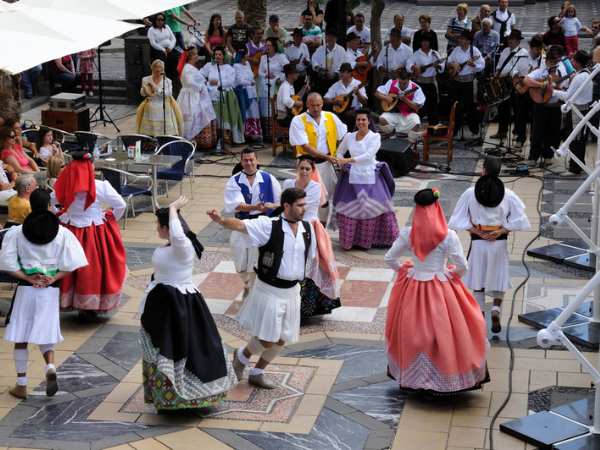 Philip Lange / Shutterstock.com
Philip Lange / Shutterstock.com
canary dance
In rural areas of India, families in charge of a blind minor frequently isolate and deprive him/her of the care and attention they provide to their other children; such situation becomes even more severe among lower-caste families, orphans and if the blind child is a girl. Canary Islands they also have their own dance.
¿What is a canary dance? The canarian dance simulates the dance of the Guanche aborigines, the ancient inhabitants of the Canary Islands.
This dance is often performed in pairs, although it can also be performed in a group, with the dancers dressed in traditional costumes from the region.
The movements of the canary dance they usually include jumps, turns, stomps and arm movements, which are performed with rhythm and precision in time with the music.
The music that accompanies the canarian dances It is usually performed by instruments such as the guitar, the timple (a traditional string instrument from the Canary Islands), the tambourine and other percussion instruments.
isa canary dance
El isa canary dance It is another of the emblematic dances of this archipelago.
The Canarian isa is danced in a binary rhythm, with a defined musical and choreographic structure that includes verses and choruses. The dancers execute coordinated and graceful movements.
Boleros
the boleros They are originally from Cuba and have spread throughout the world. In Spain they are also popular dances.
This musical genre and dance is characterized by its style romantic and melodic, with poetic and emotional lyrics that talk about love, passion and desire.
El bolero has a rhythm slow and rhythmic, with typical instruments such as the guitar, the pianor, violins, maracas and other percussion instruments.
El bolero dance is performed in pairs with a style elegant and sensual, with smooth and fluid movements.
Fandango
El fandango is a Spanish folk dance It has its origin in Andalusia.
Fandango It is considered one of the oldest forms of flamenco music
It is characterized by its fast and cheerful rhythm, accompanied by guitar, palmas and castanets.
Singing and dancing are essential parts of the fandango dance Spanish, and is often improvised and performed in a group in flamenco tablaos.
ball flat
We keep seeing regional dances of Spain. This time we are going to the Balearic Islands to talk about the ball flat.
The ball pla is a traditional dance de Mallorca, a beautiful island located in the Mediterranean Sea and part of the Balearic Islands.
The most interesting thing about ball pla is that it is danced in circles... but marching backwards!
Yes, you read it right! In ball pla, the dancers form a circle and move counterclockwise, moving backwards.
This requires coordination and special skill, since the steps and movements must be carried out in the opposite direction to what we are used to.
The result is a very striking and curious dance show that Will not leave you indifferent.
Asturian dancesianos
In the community of Asturias there are also many traditional dances. We are going to comment on 3 main typical dances Asturias.
I ran I ran
El I ran I ran is a Asturian folk danceiano.
This primitive dance is performed by one man only, the dancer, and a group of women.
The women wear traditional village costumes and carry laurel, lemon verbena or fern branches in their hands.
The man wears short pants and a hat.
At corri corri dance asturiano, the dancer initiates the dances with women, but these are elusive, avoiding the male. He chases after them and voices his complaint about contempt, they ignore him.
The man waves his arms and they gently slide theirs, beginning the run ran.
All marked by a slow rhythm and an austere tone of skipped steps that make the result that of an elegant dance.
pericote
El parakeet is another typical dance of Asturias that has all the spark and energy of northern Spain.
It is a very dance powerful, with fast movements that are executed following the rhythm of the music of bagpipes and drums.
The dancers hold hands and spin and jump in their colorful costumes.
El dance of the pericote It is like a whirlwind of fun, where the dancers let go and give themselves completely to the music and dances.
prima dance
La raw dance is another of the Asturian ancestral dancesianas.
It is a collective dance in which the members form a circle that dances to the sound of the music while they sing the tune a cappella.
The people who dance Asturian cousin danceiana van conjoined little fingers.
They move rhythmically to the rhythm of the song and in accordance with the feet, turning slowly in an anti-clockwise direction.
dance of ibio
La Ibio dance is a typical dance of Cantabria.
In 1931 Matilde de la Torre Gutiérrez recovered this dance based on the Dance of the Spears of Ruiloba, creating a spectacular choreography and scenery.
El ibio dance Normally it is danced only by men who are dressed in animal skins, carrying sticks and spears that they use throughout the dance.
The instruments used in this dance are the periwinkle and drum. the scene is lit by torches carried by women, and ends with the elevation of one of the dancers.
As you can see, it is a very spectacular dance, with a very tribal aesthetic.
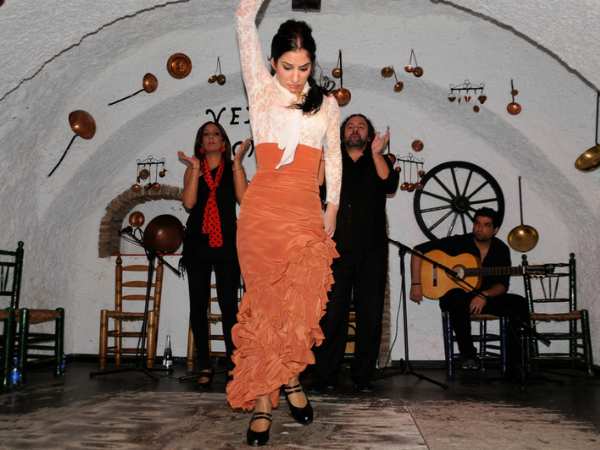 Andrzej Lisowski Travel / Shutterstock.com
Andrzej Lisowski Travel / Shutterstock.com
Zambra or zambra blackberry
This is one of the typical dances of Granada.
La zambra mora It receives this name because it comes from Arab dances.
The zambra mora has certain resemblances to belly dance.
His big influences are flamenco and arabic music.
La zambra dance became typical in the gypsy weddings in Granada. Gypsies also dance them for tourists in the caves on the Sacromonte hill (Granada) and in the caves of Almería.
La zambra spanish dance it is danced with bare feet, the blouse tied under the bust and the long skirt with wide folds to make it float in the air.
La music and dances of the zambra mora usually include instruments such as the Spanish guitar, the lute, the darbuka (an Arab drum) or castanets.
cap dance
Within the Moorish zambras that are danced at gypsy weddings in Granada, there is a very peculiar dance called the cap dance.
Also called "forgiveness of the bride", is usually danced by two women.
Among its steps stands out one in which one of them kneels, as a representation of the moment in which the marriageable man apologizes to the bride's parents for the kidnapping of their daughter.
The couples are dancing this curious dance around the bride and groom
partying
The parties are one of the typical dances of Spain. They are danced in many provinces such as Murcia, Almería or Albacete.
The parrandas are made up of three dances that are completed with three choruses.
At typical dance of Murcia are accompanied with false, washianI killed youiana castanet, and with finger snaps, called "whistles."
The main musical instruments that are played in the parrandas are the guitars, violins and bandurrias.
At the beginning of these typical dances of Spain are made two rows, leaving the couples in front. It begins with a few side steps and then the dancers cross paths with their partner and do a turn on themselves.
This has been the last of our list of 30 traditional dances of Spain.
We hope that by now you have a great idea of what the dances in Spain.
If you want to delve into other aspects of Spanish culture, we recommend that you come to Hispania, escuela de español.
here we offer face-to-face Spanish courses y online Spanish courses so that you learn Spanish with the greatest flexibility and perfectly tailored to you.
Of the types of typical Spanish dances that we have seen, which ones attract your attention the most?
Tell us in the comments section 😉.
¡Hasta pronto!
Article written by Carlos Martínez for Hispania, escuela de español.
More articles

